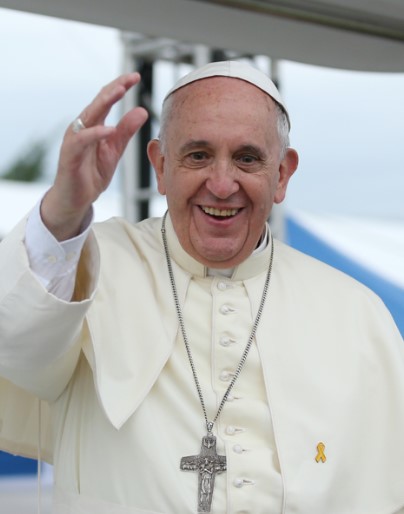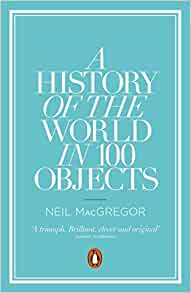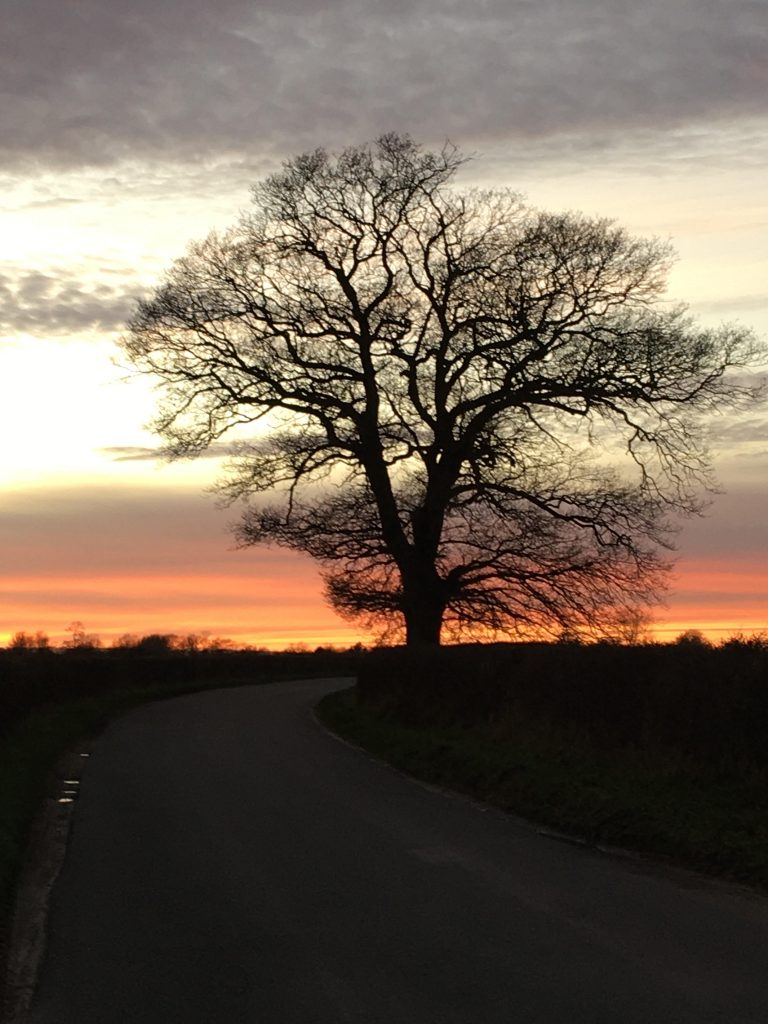I was sent these words by Pope Francis (b. 1936; r. 2013 -) as a Christmas message from a friend in Beijing. Both the source and the sentiment may seem surprising to some:

Rivers do not drink their own water; trees do not eat their own fruit; the sun does not shine on itself and flowers do not spread their fragrance for themselves. Living for others is a rule of nature. We are all born to help each other. No matter how difficult it is … Life is good when you are happy; but much better when others are happy because of you. … Let us all remember then that every changing colour of a leaf is beautiful and every changing situation of life is meaningful, both need very clear vision. So do not grumble or complain, let us instead remember that Pain is a sign that we are alive, Problems are a sign that we are strong and Prayer is a sign we are not alone! … If we can acknowledge these truths and condition our hearts and minds, our lives will be more meaningful, different and worthwhile.
The world is working well when I am reminded by an unexpected source of something I shouldn’t forget! – in this case, the precious gift of a divine creation by a land not famed for honouring it!! Listening to ‘what the world is saying to us’ is not only a mantra of ecologists: it is a commonsensical piece of wisdom at the start of a New Year. Not that interpreting the ‘signs of the times’ is ever easy; far from it. As Pope Francis points out, ‘pain’ and ‘problems’ are part of our human condition; perhaps never more clearly so than in a global pandemic. That doesn’t mean we shouldn’t try to listen and learn from ‘what the world is saying’.
But let’s be clear, if we are going to see and hear what the world is saying at the start of a New Year, more is needed than polished spectacles and sensitive ears. We need a certain ‘cast of mind’ and an alertness to detail. Pride and generalization will not do. We need to be ready to slough prejudice and to be open to change; to be humble in correction and willing to embrace new priorities. Lest this seem unimaginable, how many of us aren’t desperate to see life recovered post-COVID and lessons learned fully implemented? If we long to see that happen, we have already begun the journey to hearing and heeding ‘what the world is saying’. After all, good news and bad news are both conveyed in a host of unexpected ways.


At the recommendation of another friend this Christmas, my wife and I have begun reading to one another the former Director of the British Museum, Neil MacGregor’s (b. 1946), A History of the World in 100 Objects (Penguin Books, 2012). Based originally on a 2010 series of BBC Radio 4 talks, the book does what its title suggests: it retells world history from its origins to the present day through selected artefacts; that is, from the magnificent 3rd century Egyptian mummy of priest Hornedjitef to British artist David Hockney’s (b. 1937) etching In the Dull Village (1966), from the 8-2 million year-old Olduvai Stone Chopping Tool found in Tanzania by the pioneering paleoanthropologist Louis Leakey (1903-72) to the modern Credit Card and Solar-powered Lamp. The point MacGregor, and the experts he calls upon, is making is that objects contain ‘messages about peoples and places, environments and interactions, about different moments in history and about our own time as we reflect upon it’ (xv). Here is our history written consciously and unconsciously into the things that humanity has made or, as often, been forced to discover and use. Such a history is as selective as it is painful. Not every object tells a happy tale. Here tragedy and slavery, death and mutilation, sickness and decay are as common as creativity and beauty, artistry and genius. To interpret such, as MacGregor urges, requires poetry as much as science, good fortune as much as patience. This is another way to listen to ‘what the world is saying’, in this case through objects.
Like Confucius, Jesus could be very direct. There is a striking occasion in Matthew’s Gospel when he turns on inquisitorial adversaries with the rebuke, ‘You know how to interpret the appearance of the sky, but you cannot interpret the signs of the times’ (Matt. 16. 3). They are good weather watchers, he is saying, but miserable students of life. They are experts on material reality and ignoramuses about spirituality and morality. They value the visible and ephemeral more than the spiritual and eternal. Yes, we might say, they see and read ‘what the world is saying’ but miss what is really going on. Their cast of mind is wrong. They miss the wood for the trees. To Jesus, they cannot and do not really read ‘the signs of the times’.

Few years since Jesus walked the byways of Galilee have begun as inauspiciously as 2021. Reading ‘the signs of these times’ is far from easy. We may, like Jesus’s interlocutors, be good at interpreting a red sky at night or stormy dawn, and pride ourselves on predicting sea levels and global warming, but the deeper truths and lessons of our times are far more difficult. But that doesn’t mean we shouldn’t try. Indeed, if ecologists readily point out the connection between greed and global warming, or hunger, water poverty and conflict, why shouldn’t religionists invoke deeper, spiritual, causes of ills the world faces? If we limit our perception to material cause and effect, are we any better than Jesus’s shallow adversaries? If we claim we can control and subdue the natural world, so it always does, and will work to our advantage, are we not as guilty of oppression and manipulation as those who abuse it? What if creation objects to the way humanity inhabits it? What if COVID is a call to read and respond to the world with more subtlety, humility, respect and reserve? When a senior member of the British government’s SAGE committee (that provides scientific and medical advice on the present pandemic) said the other day, ‘Science and society will get us out of this crisis’, is it wrong to ask if he is reading all the world (and the virus) may be saying? The role of viruses in the grand scheme of things is, after all, jolly hard to explain without drawing on more than science and medicine!
Reciprocity is pivotal to much spiritual reflection on the way humans should interact with their environment. Alas, science is as susceptible to the temptation of wanting to control the environment as industrialists and corporations to debasing and denuding it. A clearer sense of reciprocity in the way we approach and use the natural world would go a long way to mitigate the effects of too many years of soil abuse and intensive farming, of plundering fish stocks and burning fossil fuels. Created objects, as Neil MacGregor’s work makes clear, tell a sorry tale of how often creation’s objections have been silenced in the quest for more.
It’s not all bad news. The natural world may not always have a smiling face, but behind it there is often a shining providence. As my wife and I have walked the fields around us here in South Oxfordshire during the pandemic, I have grown to treasure two messages objects in the natural world seem to have been sending.

First, the message of durability that exudes a vast old oak that overhangs the lane as you drive into our hamlet. It has seen many storms and summers over the centuries. It has lost branches and offered shelter. It has died and risen again with each succeeding winter and spring. I can lean on that oak and listen to it. Like other creation objects, as MacGregor puts it, it contains its own message ‘about peoples and places, environments and interactions, about different moments in history and about our own time as we reflect upon it’. The oak reminds us, surely, this pandemic will pass, if not this Spring then in another new year. A fine Christian publishing house in China that translates classic works is aptly named Oak Tree Publishing. Durability is a mark of wisdom as much as of values and realities that last.

Second, the message of recovery. We live north of the Chiltern Hills, a rolling landscape of ‘outstanding natural beauty’ full of forests and fields, villages and market towns, that run for 45 miles or so and cover 660 square miles 30 miles northwest of London and beyond. Red Kites that were extinct in Britain were reintroduced via the Chilterns between 1989 and 1994 with pairs of birds from Spain. They represent now one of the greatest success stories in contemporary conservation. The fields around our home are alive with their red tail feathers, mewing cry and soaring glides. What does the world say to me through them? Recovery is possible. Desecration and decay may not be the last word. COVID may cripple economies and decimate families, but nature knows how to recover. Or, as I was reminded by that friend from the unlikely land of China, Pope Francis was right, ‘Pain is a sign that we are alive, Problems are a sign that we are strong and Prayer is a sign we are not alone.’ To the Old Testament Psalmist, ‘day after day’ the natural world ‘pours forth speech’ (Ps. 19. 1). The pressing issue right now is, I suggest, Are we ready and able to sit and listen?
An Oxford House motto, or resolution, for the New Year? Read more carefully, think more deeply, act more decisively. Like it or not, we may need to as this extraordinary year unfolds.
Christopher Hancock, Director
